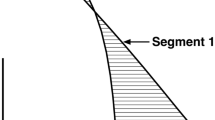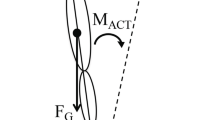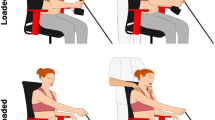Abstract
We tested the hypothesis that the upper and lower arm act as a coordinative structure coupled through a higher order control system. Five healthy participants moved their hand between two targets in ten conditions via internal/external rotation of the shoulder. In eight conditions, the task required concurrent rotation of the lower arm (180° pronation/supination). Movements were stereotypical within a condition but plotting the upper and lower arm angle against each other produced an asymmetrical pattern. With internal rotation, the upper arm reached peak angular velocity slower than the lower arm but this was reversed with external rotation. In two conditions, participants were asked to move faster and slower than their normal speed. The peak speed, time to peak speed and duration were predictable for the different tasks. Internal and external asymmetries decreased with faster movements. In addition a decrease in upper arm amplitude (from 90° to 30°) removed the asymmetry. The asymmetry was unaffected by initial posture but was exaggerated when external rotation was paired with pronation rather than supination, and internal rotation combined with supination (versus pronation). However, the presence of the same fundamental pattern suggests that the asymmetry is not due to biomechanical factors but might arise because of the difficulties involved in visually monitoring the hand when it is close to the body. The results support the idea that functional coupling can occur between upper and lower arm rotations and thus provides further evidence for a higher order control system which is responsible for coordination of arm segment movement.








Similar content being viewed by others
References
Bernstein NA (1967) The co-ordination and regulation of movements. Pergamon Press, Oxford
Desmurget M, Prablanc C (1997) Postural control of three-dimensional prehension movements. J Neurophysiol 77:452–464
Desmurget M, Prablanc C, Arzi M, Rossetti Y, Paulignan Y, Urquizar C (1996) Integrated control of hand transport and orientation during prehension movements. Exp Brain Res 110:265–278
Desmurget M, Grea H, Prablanc C (1998) Final posture of the upper limb depends on the initial position of the hand during prehension movements. Exp Brain Res 119:511–516
Jackson AE, Culmer PR, Makower S, Holt RJ, Levesley MC, Richardson RC, Cozens JA, Mon Williams M, Bhakta BB (2007) Dual Robot System for Upper Limb Rehabilitation after Stroke: The design process. Proc Inst Mech Eng Part C 221(7):845–857
Jeannerod M (1988) The neural and behavioural organization of goal-directed movements. Clarendon, Oxford
Lacquaniti F, Soechting JF (1982) Coordination of arm and wrist motion during a reaching task. J Neurosci 2:399–408
Mamassian P (1997) Prehension of objects oriented in three-dimensional space. Exp Brain Res 114:235–245
Marrotta JJ, Medendorp WP, Crawford JD (2003) Kinematic rules for upper and lower arm contributions to grasp orientation. J Neurophysiol 90:3816–3827
Reinschmidt C, Van den Bogert AJ. (1997) KineMat: a MATLAB™ toolbox for the reconstruction of spatial marker positions and the analysis of three-dimensional joint movements. Calgary Human Performance Laboratory. http://isbweb.org/software/movanal/kinemat/index.html
Soechting JF, Lacquaniti F (1981) Invariant characteristics of a pointing movement in man. J Neurosci 1:710–720
Soderkvist I, Wedin PA (1993) Determining the movements of the skeleton using well-configured markers. J Biomech 26:1473–1477
Van Bergen E, Van Swieten LM, Williams JHG, Mon-Williams M (2007) The effect of orientation on prehension movement time. Exp Brain Res 178:190–193
Tuller B, Fitch HL, Turvey MT (1982) The Bernstein perspective: II. The concept of muscle linkage or coordinative structure. In: Kelso JAS (ed) Human motor behavior: an introduction. Erlbaum, Hillsdale
Author information
Authors and Affiliations
Corresponding author
Rights and permissions
About this article
Cite this article
Alazmani, A., Culmer, P., Levesley, M. et al. The coordination of upper and lower arm rotation. Exp Brain Res 192, 635–649 (2009). https://doi.org/10.1007/s00221-008-1577-4
Received:
Accepted:
Published:
Issue Date:
DOI: https://doi.org/10.1007/s00221-008-1577-4




